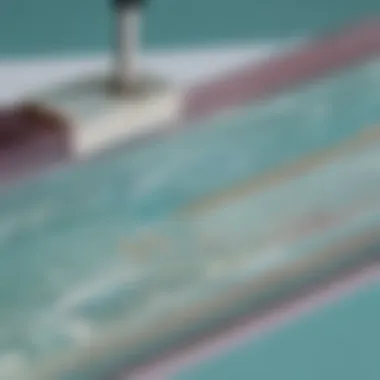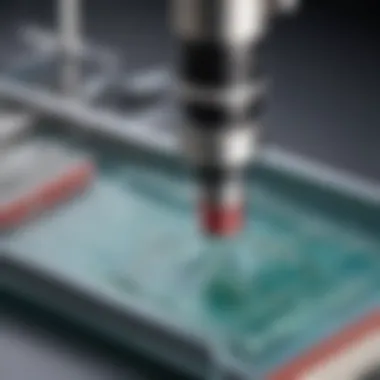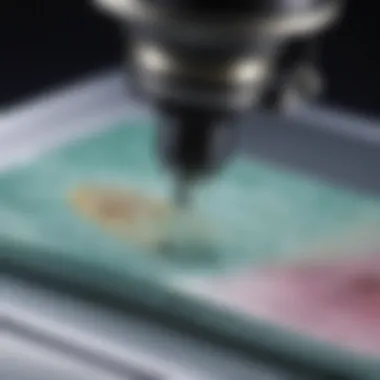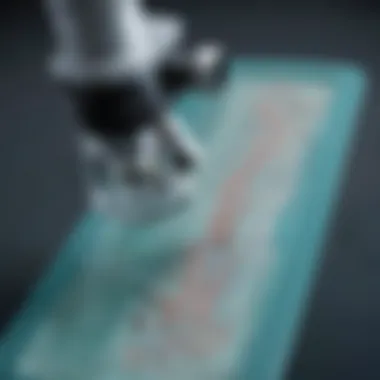Unveiling the Intricacies of Microscope Slide Stage: An In-Depth Exploration


Science Fun Facts
Microscopes have been playing a vital role in scientific research for centuries, allowing us to perceive the unseen intricacies of the microscopic world. Did you know that the first compound microscope was invented in the late 16th century, paving the way for groundbreaking discoveries in biology and medicine? Imagine the excitement of early scientists as they peered through these rudimentary lenses, unlocking a realm of hidden wonders and mysteries.
As microscopy advanced through the centuries, scientists like Antony van Leeuwenhoek, with his meticulously crafted lenses, delved deeper into the microcosm, revealing a universe of tiny organisms bustling with life. The fine art of slide preparation became an essential skill, enabling researchers to capture and study these minute marvels in exquisite detail. Each slide tells a story, holding within it a miniature world waiting to be explored and examined.
The microscope slide stage, a key component of every microscope, serves as the platform for these microscopic adventures. Imagine it as a miniature theater stage, where tiny actors - cells, microbes, and intricate structures - play out their roles under the gaze of an eager audience. With precise movements and adjustments, scientists can navigate this stage, bringing tiny specimens into focus and unraveling their hidden secrets.
Discover the Wonders of Science
In the vast landscape of scientific exploration, the microscope slide stage stands as a gateway to a hidden realm teeming with life and activity. Through the lens of a microscope, we can witness the intricate dance of cells dividing, the bustling colonies of bacteria, and the delicate structures of plant tissues. Each slide offers a new perspective, a closer look at the building blocks of life that shape our world.
Educational videos and animations provide a dynamic avenue to traverse the world of microscopy, offering a visual feast of cellular landscapes and biological marvels. With interactive learning tools, aspiring scientists can engage in virtual microscopy, honing their skills in specimen observation and analysis. Real-life applications of microscopy extend far beyond the laboratory, influencing fields as diverse as medicine, forensics, and environmental science.
Science Quiz Time
Engaging young minds in the wonders of science can be joyful and enriching. Interactive quizzes, multiple-choice questions, brain teasers, and puzzles offer a playful way to test knowledge and spark curiosity. Can you identify the parts of a microscope slide stage? What happens when you adjust the different knobs of a microscope? Dive into the realm of microscopy with fun and educational quiz sessions that challenge and inspire.
Learning through gamification transforms scientific exploration into an exciting adventure, where young learners navigate the realms of microbiology through games and activities. Stimulate critical thinking and problem-solving skills with microscopy-themed puzzles and challenges. As young scientists tackle these brain teasers, they sharpen their observational abilities and deepen their understanding of the microscopic world.
Science Experiment Showcase
Hands-on experimentation brings science to life, turning abstract concepts into tangible discoveries. Fun and engaging experiments allow budding scientists to explore the principles of microscopy firsthand, preparing their own microscope slides and observing various specimens. Step-by-step instructions guide them through the process, ensuring safe and educational exploration.
Providing a list of materials needed for each experiment empowers young scientists to gather the necessary tools and supplies, fostering a sense of responsibility and organization. Safety tips and precautions underscore the importance of cautious experimentation, emphasizing the need for adult supervision and adherence to laboratory protocols. With each experiment, children delve deeper into the world of microscopy, uncovering its wonders through hands-on discovery.
Introduction to Microscope Slide Stage
The Introduction to Microscope Slide)^$*( Stage plays a crucial role in the field of microscopy, serving as the platform where specimens are placed for observation. This section delves into the fundamental aspects of the microscope slide stage, shedding light on its significance and functionality. Understanding the nuances of the slide stage is essential for every microscopy enthusiast and professional alike. By exploring its structural components, mechanisms, and operational principles, one can gain valuable insights into how this integral part of a microscope facilitates detailed imaging and analysis.


Definition of Microscope Slide Stage
Expanding on the concept of a microscope slide stage, it is a component of the microscope that holds the slide))_)(* containing the specimen. This stationary platform provides stability and support for the slide during examination, ensuring precise positioning for accurate observation. The stage typically features clips or clamps to secure the slide in place, allowing for smooth manipulation and focus adjustment. Understanding the definition of the microscope slide stage is foundational for grasping its role in microscopy and its impact on sample analysis.
Importance of Microscope Slide Stage
The Importance^&%_ of the Microscope Slide Stage cannot be overstated in the realm of microscopy. It serves as the foundation for viewing specimens under the microscope, offering stability and control essential for accurate observations. Without a functional slide stage, it would be challenging to maintain the necessary focus and positioning required for detailed imaging. The slide stage enables researchers and students to navigate through specimens with precision, exploring fine details and structures with ease. By comprehending the significance of the microscope slide stage, individuals can elevate their microscopy experience and ensure optimal results in their research and studies.
Functional Components
Functional components play a crucial role in the functionality of the microscope slide stage. Within the realm of microscopy, these components are essential for ensuring precise movement and adjustment of slides for detailed analysis. When exploring the functional components of a microscope slide stage, one must consider the significance of stage clips, mechanical stage controls, and stage adjustment knobs.
Stage Clips
Stage clips are small but fundamental parts of the microscope slide stage. Their primary function is to securely hold the slide in place during observation under the microscope. These clips prevent the slide from shifting or moving, thus ensuring that the specimen remains within the field of view. Stage clips are designed to be user-friendly, allowing easy insertion and removal of slides for efficient workflow. When selecting a microscope slide stage, the quality and durability of stage clips are paramount considerations to enhance the stability and accuracy of observations.
Mechanical Stage Controls
Mechanical stage controls are mechanisms that enable precise movement of the slide in both the x and y directions. These controls provide the user with the ability to navigate the slide across the stage for thorough examination of different areas. The smooth operation of mechanical stage controls is essential for controlling the positioning of the specimen under the lens. Understanding how to manipulate these controls effectively is vital for accurate observation and analysis, making them indispensable components of a microscope slide stage.
Stage Adjustment Knobs
Stage adjustment knobs allow for fine adjustments to the focus and alignment of the specimen on the slide. By turning these knobs, users can move the slide slightly in different directions to achieve optimal clarity and resolution. The sensitivity and precision of stage adjustment knobs are critical for obtaining detailed images and data during microscopy. Regular calibration and maintenance of these knobs are necessary to ensure smooth operation and accurate results in scientific investigations. Overall, the functional components of a microscope slide stage work in harmony to facilitate meticulous observation and analysis in the field of microscopy.
Types of Microscope Slide Stages
In the realm of microscopy, understanding the variegated landscape of types of microscope slide stages is paramount. These pivotal platforms serve as the foundation for studying minute specimens under the microscope's scrutiny. As we unravel the nuances of fixed, mechanical, and motorized stages, an intricate tapestry of functionality and purpose emerges.
Fixed Stage
The fixed stage stands as a stalwart in the world of microscopy, providing a stable platform for positioning slides and specimens. Its immovable nature grants researchers the reliability needed for precise examination. This steadfast feature ensures that specimens remain in focus, contributing to accurate analysis and observations. The simplicity of the fixed stage hides its crucial role in maintaining consistency and facilitating detailed exploration.


Mechanical Stage
Contrary to the steadfastness of the fixed stage, the mechanical stage introduces an element of controlled movement. Researchers can manipulate the position of slides with precision, allowing for systematic scanning and observation. The fluidity of motion offered by the mechanical stage enables users to navigate specimens seamlessly, uncovering intricate details and structures with ease. This dynamic component adds a layer of flexibility to microscopy, enhancing the exploration of varied samples.
Motorized Stage
Enter the motorized stage, a pinnacle of technological advancement in microscopy. This automated marvel streamlines the process of sample examination with motorized precision. Researchers can remotely control slide movements, adjust positions without manual intervention, and explore specimens with enhanced efficiency. The motorized stage revolutionizes microscopy by reducing tedious manual labor, offering unparalleled convenience, and opening doors to streamlined research processes. Its integration marks a significant leap forward in microscopy technology, paving the way for optimized workflows and enhanced experimental capabilities.
Using the Microscope Slide Stage
When it comes to using the microscope slide stage, it is essential for achieving accurate and precise observations in the field of microscopy. The slide stage serves as the platform where the specimen slide is placed for examination under the microscope. Its significance lies in providing stability and control, allowing researchers, scientists, and students to manipulate the position of the specimen with utmost precision. By utilizing the microscope slide stage, users can achieve focused and detailed images of the microscopic world, enhancing their understanding and analysis of various samples. The ability to move the slide in different directions facilitates thorough exploration and comprehensive study of the specimen. Understanding the functions and capabilities of the microscope slide stage is crucial for obtaining clear and reliable results in microscopy.
Preparing the Slide
Preparing the slide is a fundamental step in the microscopy process. It involves carefully placing the specimen on a glass slide, often using a mounting medium to secure the sample in place. The specimen should be positioned in the center of the slide to ensure optimal viewing and imaging. Additionally, removing any air bubbles or debris from the slide is crucial to prevent distortions in the microscope's field of view. Properly preparing the slide ensures that the specimen is adequately supported and allows for accurate examination under the microscope. Attention to detail during this stage of the process sets the foundation for successful microscopy analysis.
Placing the Slide on the Stage
Once the slide is prepared, the next step is to place it on the microscope slide stage. Care must be taken to align the slide with the stage clips to secure it in place. Proper alignment ensures that the specimen remains stationary during observation, preventing any unwanted movement that could disrupt the imaging process. Placing the slide correctly allows for smooth manipulation of the stage controls, facilitating precise adjustments for viewing the specimen from different angles and focal points. Taking the time to position the slide accurately contributes to the overall efficiency and accuracy of the microscopy examination.
Adjusting the Stage for Viewing
Adjusting the stage for optimal viewing is a critical aspect of utilizing the microscope slide stage. By using the stage adjustment knobs, users can move the slide horizontally and vertically to achieve the desired field of view. This adjustment capability enables users to focus on specific areas of interest within the specimen, fine-tuning the image for detailed analysis. Proper adjustment of the stage ensures that the specimen is in sharp focus, allowing for clear visual examination. By mastering the art of stage adjustment, individuals can enhance their microscopy experience, uncovering intricate details within the microscopic world.
Maintenance and Care
Maintenance and Care of the microscope slide stage play a crucial role in ensuring its longevity and optimal performance. Proper upkeep not only prolongs the life of the stage but also contributes to the accuracy of microscopic observations overall. One of the key elements to consider in Maintenance and Care is regular cleaning and inspection of the stage components. By keeping the stage free from dust, debris, and other contaminants, users can prevent potential obstructions that may hinder slide movement or affect image clarity . Additionally, thorough Maintenance and Care routines help in identifying any signs of wear and tear on the stage, allowing for timely repairs or replacements to maintain its functionality .
Cleaning the Stage
Cleaning the stage is a fundamental aspect of its Maintenance and Care routine. To clean the stage effectively, start by removing any slides or specimens present. Then, using a soft, lint-free cloth slightly dampened with a gentle cleaning solution, wipe down the stage surface carefully. Take care to avoid excessive moisture, as it can seep into the stage mechanism and cause damage. Pay special attention to areas around the stage clips and adjustment knobs, as debris tends to accumulate in these spots. Finally, ensure that the stage is completely dry before reinserting any slides .


Avoiding Damages
To prevent damages to the microscope slide stage, it is essential to handle the equipment with care and caution. Avoid placing heavy objects on the stage, as this can exert unnecessary pressure and potentially cause structural damage . When adjusting the stage controls, do so gently and avoid applying excessive force to prevent components from breaking or becoming misaligned. Furthermore, it is advisable to store the microscope in a secure location when not in use to avoid accidental bumps or falls that could result in damages .
Proper Storage
Proper storage of the microscope slide stage is vital for maintaining its integrity and functionality over time. When not in use, ensure that the microscope is covered or kept in a dust-free environment to prevent debris from settling on the stage . Additionally, store the microscope in a stable position to avoid any accidental tipping or falling. Properly securing the microscope when not in use can significantly reduce the risk of damages and prolong its lifespan. By incorporating these Maintenance and Care practices into regular use, users can optimize the performance and longevity of their microscope slide stage.
Innovations in Slide Stage Technology
In the realm of microscopic exploration, innovations in slide stage technology stand at the forefront of enhancing precision, efficiency, and overall user experience during microscopy sessions. The evolution of microscope slide stages has not only revolutionized scientific research but has also simplified the way we interact with microscopic specimens. Let us delve deeper into the significance of these technological advancements within the context of this article.
The incorporation of digital imaging integration within microscope slide stages has redefined the way researchers capture, analyze, and store microscopic images. This advancement not only streamlines the image acquisition process but also ensures high-resolution output for detailed inspections and research analyses. **** Proponents of digital imaging integration can attest to its unparalleled convenience and accuracy in recording microscopic data, making it a pivotal element in modern microscopy practices.
Similarly, automated stage movement has emerged as a game-changer in microscope slide stage technology. By enabling automated movement and positioning of specimens, researchers can explore different areas of a sample with unparalleled precision and repeatability. Such automation not only saves time but also minimizes human error, leading to more reliable research outcomes and data interpretations.
Moreover, the integration of remote control features has further enhanced the usability and flexibility of microscope slide stages. Researchers can now manipulate stage movements and adjustments remotely, offering convenience during collaborative research projects or when operating advanced microscopic systems. **** This feature not only promotes ease of use but also opens up new possibilities in research methodologies and experimental design, revolutionizing the way scientists interact with microscopic specimens.
Conclusion
The conclusion section of this comprehensive guide provides a crucial wrap-up to the detailed exploration of the microscope slide stage. In the realm of microscopy, the slide stage stands as the foundation upon which the entire viewing process rests. Its significance lies in offering precise control over the positioning of the specimen for examination, ensuring optimal viewing angles and clarity. Moreover, the slide stage facilitates smooth adjustments, allowing researchers to navigate through the microscopic landscape with ease and accuracy.
From a practical standpoint, understanding the nuances of the slide stage translates into improved experimental outcomes and enhanced research quality. Researchers can manipulate specimens effectively, capturing desired images and data for analysis. The ergonomic design of modern slide stages also promotes user-friendly experiences, reducing strain and fatigue during extended microscopy sessions.
In contemplating the relevance of the conclusion section, it becomes evident that delving into the intricacies of the microscope slide stage paves the way for a deeper appreciation of microscopy as a scientific discipline. By underscoring the role of the slide stage in facilitating precise observations, this guide serves as a valuable resource for both amateur enthusiasts and seasoned professionals, illuminating the path to advanced microscopy practices.
Summary of Key Points
The summary of key points section encapsulates the essence of the microscope slide stage exploration, distilling complex information into actionable insights. Throughout this guide, we have elucidated the diverse components and functionalities of the microscope slide stage, shedding light on every critical aspect that contributes to its operational efficacy. From the significance of stage clips to the intricate maneuverability afforded by mechanical stage controls, each element plays a pivotal role in enhancing the microscopy experience.
Additionally, our journey through the types of microscope slide stages—from fixed to motorized—has underscored the evolution of stage technology and its impact on research methodologies. By elucidating the process of using the slide stage, from slide preparation to optimal viewing adjustments, this guide empowers readers to navigate the microscopic realm with confidence and precision. Emphasizing maintenance protocols and care practices ensures the longevity and efficiency of microscope slide stages, safeguarding their functionality for prolonged scientific exploration.
Future Trends in Microscopy Stages
The landscape of microscopy stages is continually evolving, with future trends poised to revolutionize research methodologies. One prominent trajectory is the integration of digital imaging technologies, enabling seamless capture and analysis of microscopic specimens. By leveraging automated stage movement, researchers can enhance workflow efficiency and accuracy, optimizing time resource allocation and data collection.
Moreover, the advent of remote control features in microscope stages heralds a new era of accessibility and convenience in microscopy. Researchers can now manipulate slide stages from remote locations, fostering collaboration and enabling real-time experimentation across geographical boundaries. These advancements not only streamline research processes but also open new avenues for cross-disciplinary studies and innovative scientific discoveries. As microscopy stages embrace technological innovation, the future promises unprecedented opportunities for transformative research ventures.







